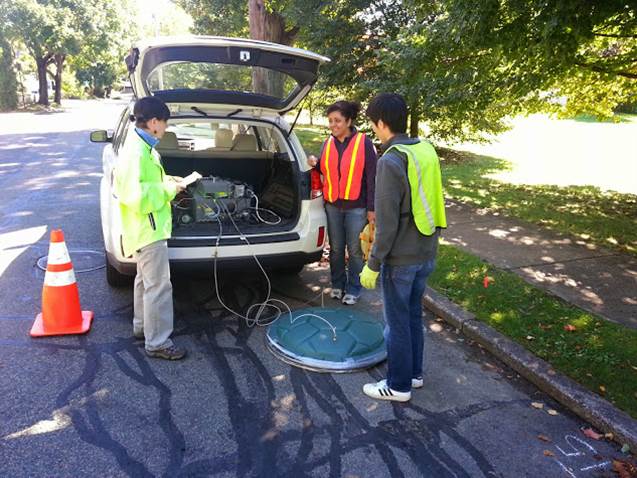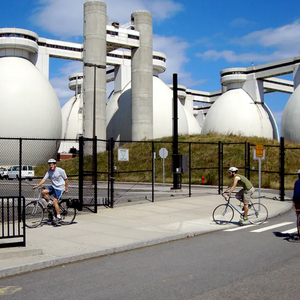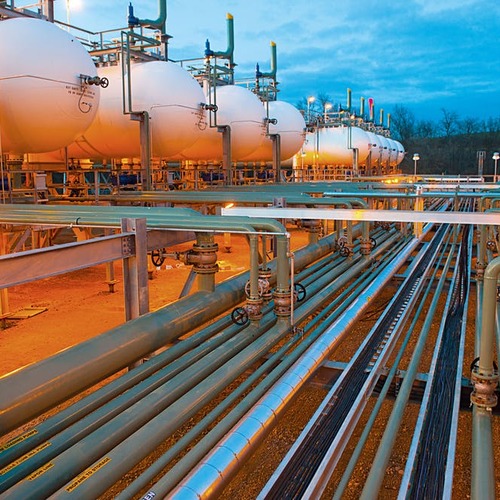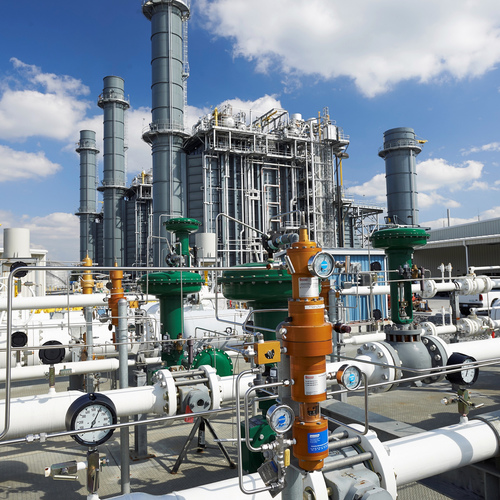
Image Credit: Nathan Phillips
The CO2 emissions associated with the burning of natural gas are less than the CO2 emissions associated with burning an equivalent amount of coal. Because of this fact, natural gas is seen by many policy makers as a “clean” alternative to coal.
In the last few years, however, climate activists have been pointing out two worrisome facts: (1) methane (natural gas) is a potent greenhouse gas — about 80 times more potent than CO2 (on a mass basis) during the first 20 years after the methane is released; and (2) our nation’s natural gas pipelines are much leakier than some people thought.
Putting these facts together, some experts have concluded that “natural gas is worse than coal.”
We need to transition away from natural gas
At the BuildingEnergy 17 conference in Boston on March 9, 2017, four experts gave a presentation called “Methane Leaks, Public Policy, and the Future of Natural Gas Grid.” The presenters were Audrey Schulman (from Cambridge HEET), Nathan Phillips (from Boston University), Patrick Parenteau (from Vermont Law School), and Marc Rosenbaum (from South Mountain Company).
Nathan Phillips, a professor at Boston University, has published several papers that focus on the scale of the gas leak problem, including Mapping urban pipeline leaks: Methane leaks across Boston and Fugitive methane emissions from leak-prone natural gas distribution infrastructure in urban environments.
The presentation was an eye-opener. After hearing from these four experts, I’m more convinced than ever of the importance of transitioning away from natural gas and focusing on all-electric solutions.
In this article, I won’t pretend to lay out all of the important research on this topic. Interested GBA readers who want to delve a little deeper can find many online articles on the effects of natural gas leaks and the scope of the problems…
Weekly Newsletter
Get building science and energy efficiency advice, plus special offers, in your inbox.

This article is only available to GBA Prime Members
Sign up for a free trial and get instant access to this article as well as GBA’s complete library of premium articles and construction details.
Start Free TrialAlready a member? Log in















16 Comments
Heat pump leaks
Excellent article, and a good reason to stop debating and choose all electric.
A note of caution: as we move to heat pumps, we should be careful that we don't simply replace methane leaks with HFC refrigerant leaks. There are lots of reasons to believe that refrigerant leaks aren't as big a problem. For one thing, if you have a refrigerant leak, you system stops working, so it has to get fixed, whereas you can ignore a methane leak and everything keeps working. But HFCs are, pound for pound, a much worse greenhouse gas. If we are going to make an effort to move to new types of systems, we should consider moving to low GWP refrigerants like CO2, and/or moving to packaged systems such as air-to-water heat pumps that have a smaller amount of refrigerant in a factory-sealed system.
Collection network vs distribution network?
So it seems that we will continue to have losses in the aged distribution network until the lossy bits are repaired or abandoned. As usage decreases, an unrepaired loss will become a larger and larger percentage of total usage.
The fracking boom has lead to a large increase in the collection network, with accompanying increases in losses. Fortunately, these are often newer, the losses are more concentrated in fewer and larger leaks (easier to find and repair), and portions of the net will probably be sealed off as the production runs out.
gas fired electricity
Thanks for writing about this, Martin. A number of past GBA blog entries have been more favorable to gas, and it's good to see wider recognition of the real risks of methane.
While a "gas vs electricity" decision for consumers has some relevance at a household level, it's worth emphasizing that the really big deal is at the utility/ public policy level. The question there is whether future grid energy will come from conservation and renewables or whether we will we build the next generation of fossil fuel infrastructure by ramping up gas powerplants as we ramp down coal and nuclear. As you point out “...a long-term solution must include elimination of the natural gas distribution system, one branch as a time.”
Right now, though, there is unfortunately a lot of movement in the other direction--toward new gas infrastrure. The gas industry is aggressively positioning itself to play a major role in grid energy production, and if industry is successful in ramping up power plant demand and access to export markets and at tamping down the effectiveness of conservation and renewables, then the all-electric bandwagon we all want will be significantly gas powered, and possibly worse from a climate standpoint than the old one.
It's been interesting to watch this debate play out here in New York. We seem to be going in opposite directions simultaneously: in 2014 governor Coumo finally caved in to demands from citizens and scientists and rejected the gas industry's application to use high volume hydrofracking to extract shale gas. But since then things have gotten confused. The state has announced that it will close the controversial India Point nuclear plants, which supply 12% of the state's electricity. At the same time the state is in the process of scaling back some of its conservation programs and permitting a massive gas infrastructure buildout that includes multiple pipeline projects to bring fracked gas up from Pennsylvania to feed enormous new gas powerplants here as well as export markets in Canada.
Critics have pointed out that it will obviously be impossible for the state to meet any of its GHG emission targets in this scenario. A similar experiment in Vermont resulted in a conspicuous failure: after closing the Yankee nuclear plant, the state turned to gas, and has been unable to bring GHG emissions down anywhere near its targets.
So I guess it's worth emphasizing again that “all-electric solutions” are only as as green as the grid that supplies them.
Response to Bennett Sandler
Bennett,
You make a good point: For those committed to reducing greenhouse gas emissions, removing the natural gas furnaces from our homes and replacing them with electric heat pumps is a necessary but insufficient step.
If our electricity grid includes power plants that burn natural gas, our homes will still be dependent on natural gas pipelines.
In short: we all have a lot of work ahead of us.
Going all-electric won't fix the gas-grid leaks.
Until/unless we're prepared to abandon the local distribution infrastructure altogether, chasing down gas-grid leaks has to be made a priority. Whether 5 houses or 500 houses are hooked up to a leaky distribution main, the leakage rate remains the same, and the cost to fix it is the same.
Large gas transmission & distribution pipelines feeding gas fired power generators usually have better maintenance schedules and defect detection (and budgets) than local residential gas grid operators, but I'm sure that varies too.
Heat & power cogenerators (whether large or small) operate at nearly twice the thermal efficiency of combined cycle gas powerplants, improving their green cred compared to coal, but are not a universal solutions. It takes a significant thermal load relative to the electricity load to make them viable.
As Bennett Sandler correctly points out, all-electric solutions are only as green as the grid that supplies them, but the verditude of that grid is not a fixed number. It evolves rapidly, and is trending toward lower carbon overall. In recent years more renewable capacity have gone onto the grid in the US than new fossil fired plants, even as inflexible nuclear & baseload coal is being retired on economic grounds. In the so-called "deregulated energy" electricity market states an all-electric customer has the option of buying from 100% renewable suppliers. Even if that power isn't being sourced locally, the net effect is pretty much the same from a net greenhouse gas point of view, and the incremental demand for that lo-carb power tips the economics favorably toward renewable power. (New York is one of those states.)
While nameplate capacity is only part of the story, the "capacity factor" of wind power is now north of 35%, sometimes north of 45% for new wind, and the capacity factors of combined cycle gas has been shrinking (even for new plants) to less than 50%. (Capacity factor is the average annual output divide by the nameplate output.) The notion that large inflexible "baseload" power such as nuclear or coal are necessary for efficient & reliable grid operation is primarily culture or habit. In the PJM region which has been at it a bit longer, demand-response has already accounted for more than 10% of the annual peak load, and expanding that to 30% of peak would still be economic. That's enough flexible load to cover a lot of daily/hourly output changes from variable output renewables. So even on regional grids such as ISO-New England where literally half the annual power going onto the grid is currently from gas (primarily combined cycle, with average thermal efficiency of about 50%), the relentless build-out of variable renewables will be cutting into the capacity factors of the gas fleet in a big way in under 10 years, especially as the build out of offshore wind mandated by Massachusetts begins to come online. In the short term retirements of nuclear power and coal power in the region may add to the capacity factors of the gas fleet, but only the pipeline-dream developers believe that those retirements are all destined to be replaced by more gas. Even if some of it is replaced by gas, those new powerplants are an order of magnitude more flexible than thermal coal or nuclear, and will continue to "play nice" with the variable renewables even as they undercut their capacity factors, something that the existing coal & nuclear baseload plants can't do.
Whether more gas plants are NEEDED in NY or the ISO-NE region as nukes and coal plants retire is open to debate. At the moment ISO-NE does not have a demand response market, even though it has been under development for several years. The market design and roll-out was delayed when the D.C. District court shot down FERC Order 745, a decision that was later overturned by the US Supreme Court. FERC Order 745 requires (among other things) that demand response be remunerated at the same rates as power generators in the wholesale electricity markets, including capacity markets and ancillary services. The projected launch of the ISO-NE demand response market is currently slated to be about a year from now, less than a year ahead of the retirement of the Pilgrim nuclear plant, and before the commissioning of the first round of offshore wind. How long it will take for it to hit PJM's double digit bite out of the grid peak remains to be seen, but it should be less than 5 years. The retirement of the Pilgrim likely to boost the capacity factors of the regional gas plants for a couple of years, but not much beyond that as more variable renewables get build. The demand response market is going to decimate the already low capacity factors of gas & oil fired peaker plants. Massachusetts has also mandated a grid storage build out to put the final nails in the peaker-plant coffins. Peakers operate at barely more than half the thermal efficiency of combined cycle plants, and the retirement of that capacity will yield a disproportionately higher reduction in CO2 emissions than taking the same Twh out of combined cycle powerplant's production.
Bottom line, year on year fluctuations in the carbon footprint of the grid is the new normal as big chunks of inflexible grid capacity get retired. But even the intermediate trend lines are strongly toward lower carbon in the northeastern US. The Vermont Yankee closure is really only significant when compared to other generation in that low-population state with very little in-state generation capacity. While Vermont is currently importing more gas-fired power over the ISO-NE grid than previously, that is a temporary condition. Vermont's largest utility Green Mountain Power is a heavy promoter & supporter of efficiency, an distributed power (on both sides of the meter) as well as distributed grid storage (again, on both sides of the meter), and the resulting mix is more flexible and lower impact than the nuclear plant it will eventually replace. As a smaller utility (compared to most NY utilities) Green Mountain Power can arrive at consensus decisions and act on them quickly, and are becoming a cutting edge example of how distributed variable output renewables can support a first-world grid. A podcast interview with GMP's CEO can be found here:
https://soundcloud.com/theinterchangepodcast/mary-powell-is-not-your-typical-utility-executive
But whether gas grid usage volumes are humongous or tiny, the methane leaks are going to be about the same until regulatory mandated monitoring & repairs go into effect.
Trimming the branches of the pipeline
As I noted in my article, "In addition to plugging the existing leaks, a long-term solution must include elimination of the natural gas distribution system, one branch as a time."
This is a good project for the "Think globally, act locally" crowd. We need to establish neighborhood goals: One cul-de-sac at a time, let's get our neighbors to go all-electric.
Once our cul-de-sac has gotten rid of the last natural gas appliance, we must lobby the local utility to cap the pipeline branch serving our street.
...or trimming the branches back one state at a time.
There is proposed legislation shuffling around the Massachusetts statehouse to make all energy fossil-fuel free by a date certain, including existing homes. The mandates would be sooner than that for new construction. (They are including personal transportation too- no fossil burners!) The current draft lives here:
https://malegislature.gov/Bills/190/S1849
If some version of that gets enacted in the next few years the heat pump biz will increase exponentially and soon dominate the market for new construction, well before it's mandatory. Retrofit hydronic heat pumps would probably start taking market share for replacement equipment shortly thereafter.
But in the nearer term simply fixing the LEAKS one cul de sac at a time goes a long way.
Its not just all-electric homes...
Martin - IMO your last comment "... it's time to join the all-electric bandwagon." should read that it's time to join the all RENEWABLE electric bandwagon. In many parts of the country, electricity is produced by coal and gas plants.
Response to Armando Cobo (Comment #7)
Armando,
Of course I agree with your exhortation that "it's time to join the all RENEWABLE electric bandwagon" -- to the extent that we can -- which is why I wrote, "the home of the future is the all-electric home — equipped (if possible) with a PV array sized to balance the home's electricity consumption."
For many reasons, it's not a good idea to build an off-grid home. (Off-grid homes can't possibly make use of all the the electricity produced by a PV array.)
While those of us who have an unshaded south-facing roof, or an unshaded patch of lawn, can put coins in a piggy bank to save for a PV array, that doesn't solve the problem of electricity grids that are fossil-fuel heavy. To fix that problem, we need to vote for the right political candidates, regularly call our Congressional representatives and Senators, participate in demonstrations, and continue to demand that our local utilities address the climate change crisis with the urgency it deserves.
@ Dana re trend lines
"But even the intermediate trend lines are strongly toward lower carbon in the northeastern US. The Vermont Yankee closure is really only significant when compared to other generation in that low-population state with very little in-state generation capacity."
Sorry Dana, I think you are wrong there. 1) New England's power generation Co2 emissions have been rising since 2014, not falling. 2) Retired nuclear power is the reason. Vermont Yankee was worth 600MW of zero-emission capacity, and that's really hard to offset. Here's the lede in one recent article on the subject:
"The retirement of Vermont Yankee nuclear station in Vernon led to higher carbon dioxide emission rates across New England for the first time in a decade, according to the latest ISO New England Electric Generator Air Emissions Report."
More here: http://www.masslive.com/news/index.ssf/2017/02/report_closure_of_vermont_yank.html
And here: http://instituteforenergyresearch.org/analysis/new-englands-emissions-rise-as-vermont-yankee-is-shuttered/
You may be right that demand response and a more flexible grid will eliminate some of the need for traditional large power plants, but I worry this glossy distributed energy future is actually code for lots of little (less regulated) gas power plants instead of a few big ones. How does the song go, "Meet the new boss, same as the old boss..."
Conservation deserves mention
Informative article. Never realized that “clean” gas distribution leakage could be such a serious problem (even though I’m an all-electric fan ☺). Agree that at an individual/family/home level, we have the power to make our homes all electric. (Sorry, couldn’t resist the puns…) Agree also that we can choose to use rooftop PV (or community or large-scale PV, wind power or other renewables). And now, agree that the gas distribution system needs monitoring, repair, and a plan for phasing it out. Can’t just ignore fossil fuel infrastructure, and hope it goes away.
Along with all that we agree upon, let’s also clearly state in our discussions (again and again) that we champion insulation, air-sealing and energy recovery. In the end, if we reduce our need for power (space heating and cooling, water heating, appliance efficiency), we reduce the need for power plants and leaky natural gas distribution systems. Its not only about using sustainable power vs. nukes and fossil fuels, its also about using less power so we don’t trash the planet to live comfortably. We probably all agree that reducing power usage is central to sustainability. To me, improving energy conservation is an important transition, and not as difficult for people to understand or debate. Most people won’t want to sign up for a large monthly all-electric bill if their energy usage is high. And they won’t need gas or oil if the building envelope is built really well.
A thre year period doesn't indicate a trend @ Bennet Sandler #10
"New England's power generation Co2 emissions have been rising since 2014, not falling. "
Seriously!?! Since 2014?
That's not a trend, that's a BLIP!
Generation assets have decades-long lifecycles, and the only trends worth considering are roughly the lifecycle of power generators. Looking at only the volatility of short sub-decade "trends" attributable to large plant closures is downright silly, similar to predicting global cooling or warming based on only a few years' data when it's the century long trend that matters, and a decade would be the minimum relevant time period one MIGHT infer a trend from.
Notice that in the quote pulled from the referenced article states:
"The retirement of Vermont Yankee nuclear station in Vernon led to higher carbon dioxide emission rates across New England....
.... FOR THE FIRST TIME IN A DECADE..."
(emphasis added)
In other words, it's newsworthy since it was a reversal of the DECLINING emissions over the prior decade (which in itself is a dubiously short time period to fully define a trend where generation assets are concerned.)
The part not quoted was:
"At the same time, New England power plant emissions have declined significantly over the last 15 years, due in large part to natural gas replacing coal and oil. Renewables are making progress, but were not able to QUICKLY replace the nuclear plant's capacity."
(emphasis added)
Note the past tense "...were..." . It's always going to be much QUICKER to replace 600MW of high capacity factor baseload capacity by increasing the capacity factors of existing gas fleet than it is to build out 1.5 gigawatts of onshore wind , but that's not to say the equivalent output of new wind & PV won't get there in a reasonable time frame. It most assuredly will, and over then next couple of decades it's going to be at a scale larger than New England's nuclear fleet.
The cause & magnitude of the reversal of the 15 year trend was TOTALLY predicable, and emissions are still lower than the 2007 peak- the blip didn't even fully erase the 10 year trend. The anticipated uptick when Pilgrim goes dark in 2019 is also totally predictable. But those short-to-intermediate term events don't define the trend.
Newer fossil burners have higher thermal efficiency than the fossil burners they replace, PV and wind have zero emissions, last for decades and over the past decade have seen an exponential increase in year-on-year installment rates. (PV may take a down-tick for 2017 after the 2016 tax-subsidy rush on projects scheduled before the tax subsidy got extended). The accumulating capacity of distributed renewables has been growing exponentially for a decade, just as regional power demand has been flat to falling for a decade. There is no reason to believe an uptick in demand is imminent (quite the contrary), and every reason to believe that the rate of installment of efficiency & renewables will remain strong (if no longer exponential) over the next decade. The 2016 the amount of newly added PV in MA alone was enough to replace more than 10% of the annual output of Vermont Yankee (adjusted for relevant capacity factors.)
It's totally predictable that the decades-long regional trend is continued enhancement of end use efficiency, continued build out of PV solar (on both sides of the meter), the build out of (mandated in MA ) grid storage, and the build out of large scale offshore wind (also mandated in MA.) Most of the PV in New England is on the ratepayer's side of the meter, not visible to the ISO operators (except as missing demand), and thus doesn't even count in the generation mix,not that it effects the absolute emmisions total. There is reason to believe that a commercial and grid scale PV will catch a second wind as new PV + storage becomes cheaper than peaker plant power (that line has already been crossed in Arizona: http://www.utilitydive.com/news/updated-tucson-electric-signs-solar-storage-ppa-for-less-than-45kwh/443293/ )
In the intermediate term, by 2024 (10 years after the closure) the uptick from the Vermont Yankee closing will have been obliterated by the build out of efficiency & renewables (and hydro imports from Canada). By 2029 (10 years after Pilgrim is toast) the associated uptick in emissions will have been more than offset by still more efficiency & renewables build out, along with hydro imports, but also the reduction in spinning reserves & peaker emissions as grid batteries scale and peakers go the way of the dodo.
We should get a better handle on offshore wind's expansion timeline before the end of the year, as proposals & bids come in, and with it better estimates of how long it will take the falling emissions trend lines to recover from recent & planned nuclear plant closures:
https://www.usnews.com/news/best-states/massachusetts/articles/2017-05-01/utilities-readying-bids-for-coastal-massachusetts-wind-farm
The build out of new transmission line capacity for importing power from Canada should be better known in the next year too. It's definitely not standing still, and the trend really is downward. Some of the newer high efficiency gas burners will probably be closed for economic reasons before their original anticipated lifecycles, just as middle-aged nukes and fossil burners are succumbing to the effects of zero marginal cost grid scale renewables driving the wholesale cost of power into the ground in the upper midwest. It took less than a decade for wind power in Iowa to go from less than 1% to over 30% of all the power pushed onto the grid in a year. At the learning curve of offshore wind it's not out of the question (though not guaranteed) for a similar thing to happen in New England.
So yes, turning off large baseload nukes has short to intermediate term impacts on emissions, but a few blips do not make a trend.
[Edited to add]
Signs of the changing-grid times:
https://www.greentechmedia.com/articles/read/chinese-wind-turbine-company-goldwind-wants-to-hire-out-of-work-coal-miners
What is Vermont Yankee's carbon footprint?
Bennett Sandler said, "Vermont Yankee was worth 600MW of zero-emission capacity". It's common to read assertions that nuclear energy has a carbon footprint of zero, but that ignores everything happening outside the reactor and turbines. I wonder if Dana, Martin, or someone else can offer a slightly more global comparison of the carbon footprint of a plant like Vermont Yankee with some of the alternatives that we have been discussing. Some people in the debate say Vermont Yankee should never have been closed, so I'd like to understand what its ongoing yearly carbon footprint looked like shortly before it was closed. However, more important is its total carbon footprint, from planning to construction, through operation, and decommissioning. How does that compare with the carbon footprint of the current alternatives?
Response to Derek Roff
Derek,
I'll provide links to two articles on the topic.
1. The first article comes from the nuclear power industry, and therefore should be taken with a grain of salt:
Greenhouse gas emissions avoided through use of nuclear energy.
2. The second article appears to be more balanced:
Nuclear energy: assessing the emissions.
Vermont Yankee's lifecycle carbon was pretty low
That reactor ran for about 40 years, a sufficiently long lifecycle to "pay off" the greenhouse gas emissions of baking all that limestone to make the concrete, among other material costs. The marginal carbon footprint per kwh of nuclear power plants is pretty tiny, but the construction material footprint is substantial. That's one of the rationales for upgrading and keeping the existing fleet of reactors going for as long as possible.
But the financial cost of the upgrades & maintenance is now higher than the levelized lifecycle cost of utility scale solar & wind, which is what's rendering them uneconomic as wholesale power prices ratchet down with increasing zero-marginal-cost renewables. In the near & intermediate term there is greenhouse gas argument for keeping them going despite the higher cost, to avoid the short term emissions blips when they shut down, but one has to assume an unrealistically long lifecycle to rationalize the construction cost of new light water reactors, let alone the initial greenhouse gas hit from the concrete. The now stalled SCANA and Vogtle reactors under construction in SC & GA may never deliver a single kwh (!), but they have already incurred a major fraction of the emissions related to the construction materials.
As-yet-commercially-unproven small modular reactors such as molten salt reactors operate at atmospheric pressure, can't blow up under pressure and thus don't need a the stout concrete containment buildings that prior generation reactors need, and should have a correspondingly better carbon footprint, if/when they ever get built. Unlike light water reactors the new reactor designs are scalable to even fit village-sized loads, and would need less load &/or grid infrastructure to be useful. They are also capable of extracting more of the energy out of the fuel- existing reactors use only 3-5% of the available energy before the fuel rods become too mechanically fragile to safely keep in service lest parts fall to the bottom and melt down and continuing to react in a less controlled fashion. In molten salt reactors there's no such thing as a melt-down of the fuel- the fuel is already molten and dissolved in designer-salt while in use. My gut tells me that the development of small modular reactor technology is already too late to the game to become competitive with incumbent low-carb power sources, but there are multiple companies out there working on it. They need to beat the rapidly declining cost learning curves of PV, wind & storage to gain a market foothold, a hurdle that gets tougher every year.
With the "electrification of everything" there is some chance that electricity demand will begin to grow, but that doesn't necessarily mean more large centralized power plants. NREL's technology assessment published last year showed that even existing PV could provide nearly half the total annual power used in the US from existing rooftops (no new real estate needs to be covered), which is a LOT of power, even if only half that gets built! There is also ample as yet unexploited offshore wind to more than double electricity production in the US, and the technology is just now getting cheap enough to be competitive, but still getting cheaper every year.
The Brattle Group think tank wonks produced this (reasonably short and readable) "electrification of everything" analysis earlier this year in response to utility company anxiety surrounding the lack of demand growth, and the potential for rapidly shrinking demand as distributed renewables keep crashing through price floors:
http://www.brattle.com/system/publications/pdfs/000/005/396/original/Electrification_-_Emerging_Opportunities_for_Utility_Growth.pdf?1485268804
Thank you, Martin and Dana.
I appreciate the links that you provided, Martin, and the additional discussion and link from Dana. (Edited to avoid two separate "thank you" posts.)
Log in or become a member to post a comment.
Sign up Log in